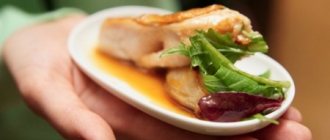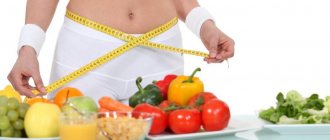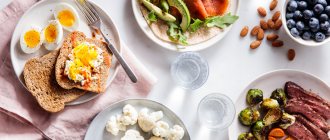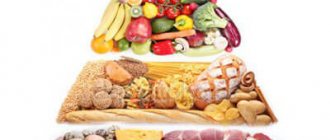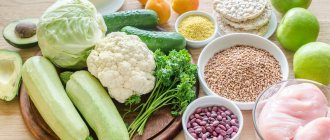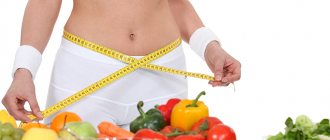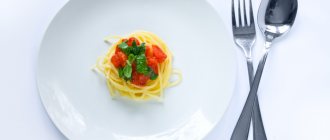A balanced diet, a varied set of foods, taking into account the individual characteristics of the body - all this is a hypocaloric diet. Get recipes for cottage cheese soufflé, homemade sweets and lose weight deliciously!
Author: Kristina Lobanovskaya, doctor, practicing nutritionist Article updated: 11/09/2020
The vast majority of diets for weight loss are based on reducing the caloric content of the diet, due to which an energy deficit is created and the body begins to use its own fat reserves to replenish it. Such weight loss methods are called low-calorie and are quite widely used by many who want to lose weight, usually without a doctor’s prescription. Along with this, in this category there is a special - hypocaloric diet, better known as “table No. 8”. Unlike other restrictive nutrition systems, it is a carefully balanced diet, the energy value of which is determined individually depending on the degree of obesity, lifestyle and individual characteristics of the patient’s body.
Principles of a hypocaloric diet
The hypocaloric diet is based on the following principles:
- Before you start a diet, you should prepare. To do this, you need to arrange fasting days for yourself, during which you eat only vegetables or kefir. This will allow the body to take the transition to a menu cut in half less painfully.
- The number of kilocalories should be reduced gradually, starting from 500 kcal per day.
- Protein products in the menu should not be cut; you should only reduce the consumption of carbohydrates by three times and the amount of fat by half.
- Sugar, salt and caffeine are limited in the diet. You should also reduce the amount of water you drink. If most dietary programs, on the contrary, recommend drinking as much fluid as possible, then a hypocaloric diet requires “drying” the body, expelling excess water from it. However, this does not mean that you cannot drink while dieting at all.
- The menu is based on eating foods that are rich in fiber, protein and vitamins.
- You need to eat often, but in small portions.
- You should not follow the proposed diet for more than 3 weeks.
The hypocaloric weight loss system allows you to speed up metabolic processes in the body, normalize blood glucose levels, and improve the health of the digestive system as a whole. The body is cleansed of toxins, toxins are released from it, fats are broken down. Against the background of general improvement, blood pressure stabilizes.
During the diet, you can play sports, but the load should be minimal. If this is not possible, then you can simply take walks or perform gymnastic exercises at home.
Low-fat diets[edit | edit code]
Proponents of low-fat diets claim that the body adapts to them easily, without shaking, which guarantees a stable result. Another advantage of this group of diets is that changes in eating habits are minimal. Read more:
High carbohydrate diet
Low-fat diets increase the risk of death, and high intake of saturated fat is associated with a significant - 35% - reduction in the risk of stroke. The results of the large-scale cohort study PURE (Prospective Urban Rural Epidemiology), which involved 135,335 people aged 35-70 years from 18 countries, both poor and rich (average follow-up time of study participants - 7.4 years), were published in the journal The Lancet[1].
Classic low-fat diet[edit | edit code]
The goal of the diet is to reduce the consumption of fatty foods, or better yet, replace them with low-fat ones, so that the amount of fat in the diet does not exceed 40 g. There are not many truly fatty foods: butter, vegetable margarine, mayonnaise, cheeses, pork sausage, sausages, sausages , fatty meats, gourmet fish (salmon, trout), cream pies, ice cream. The task is to replace fatty meat with lean meat, salmon with cod, cheese with cottage cheese or feta cheese, cake with marmalade, jam, marshmallows, etc.
Choose only boiled, baked or grilled meat, bread made from wholemeal flour, and dairy products low in fat. Beans, nuts, chocolate, cocoa, sugar, jams, marmalade and alcohol will be prohibited during the diet. If you follow this prohibition, then the calorie content of other foods can not be counted.
The basis of your menu will be vegetables, mushrooms, and fruits. Following a low-fat diet reduces the risk of cardiovascular disease, liver disease and kidney disease. However, a low-fat menu is a way to lose weight, and not an option for proper nutrition. Long-term exclusion of fatty foods from the diet can cause a deficiency of vitamins A, D, K, E, which leads to physical and mental fatigue, disruption of the menstrual cycle in women, dry skin and hair loss.
The first low-fat diet option
- First breakfast
: 2 soft-boiled eggs; 1/2 grapefruit; 1 orange; 1 apple; 200 ml prune compote; 25g wholemeal bread with light butter. - Second breakfast
: 100 g of fruit salad with raisins and nuts; 400 ml fruit juice. - Lunch
: 25 g wholemeal bread with light butter; 100 g of tomato salad with herbs; 100 g fruit salad; 200 ml juice. - Dinner
: 150 ml vegetable soup; 90 g lean meat or fish; 3 egg omelette with potatoes; 150 g green salad. Alternatively, you can eat 100 g of pasta; 60 g pudding with semolina; 150 g vegetable salad; 200 ml compote.
The second option for a low-fat diet
- First breakfast
: 20 g breakfast cereal; 250 ml skim milk; 1 banana. - Second breakfast
: 2 jacket potatoes; 100 g green salad. - Lunch
: 200 ml of onion soup with potatoes; 100 g chicken with brown rice and curry sauce; 40 g marshmallows; 200 ml low-fat yogurt or 100 g low-fat cottage cheese. - Dinner
: 2 low-fat cottage cheese pancakes; 200 ml
low-fat kefir.
The weight comes off slowly (1-4 kg per month), but surely.
Types of hypocaloric diets
There are 4 types of the Pevzner diet, which depend on how much excess weight a person has:
- Diet 1800 kcal - this diet is suitable for those people who suffer from excess body weight, but they have not developed obesity.
- Diet 1500 kcal - this diet is suitable for people with the first stage of obesity.
- Diet 1200 kcal - this diet is prescribed to people with second degree obesity.
- 800 kcal diet - such a diet can only be prescribed by a doctor and only to those people who suffer from 3-4 degrees of obesity. While observing it, a person must adhere to bed rest.
There are also foreign versions of the hypocaloric diet, which range from 500 to 1800 kcal. The Western diet also differs from the Pevzner diet in that it reduces the amount of fat: 20 g per day on a foreign diet versus 40-60 g of fat on a Russian diet.
However, regardless of which diet option was chosen for weight loss, you need to enter it correctly. Without the preparatory stage, it is prohibited to sharply reduce the number of kilocalories. Every day you need to reduce your daily caloric intake by 500 kcal until its values reach 1300 kcal. Only after this can you switch to a low-calorie diet menu in the full sense of the word.
General Diet Information
Content:
- General Diet Information
- How does hypocaloric work?
- Types of hypocaloric diet
- How to choose foods for your diet
- Hypocaloric diet: classic menu
The hypocaloric diet, or table No. 8, is a balanced nutrition system, the total daily calorie content of which, most often, does not exceed 1200 kcal. This program was developed by professional nutritionists for people who are obese and lead a sedentary lifestyle. It is the balance of the diet that distinguishes the hypocaloric diet from other low-calorie analogues. Unlike most “hunger” nutrition programs, the hypocaloric diet includes foods from all major groups.
And these are dairy and protein foods, fruits, vegetables, grains, and healthy fats. The hypocaloric system provides for fractional meals. In addition to 3 main meals, you will have to make 2 snacks during the day, which can consist of fruits, vegetables in thermally unprocessed form or milk.
The duration of the diet is determined by the doctor, based on the individual characteristics of the patient’s body. But in any case, it is prohibited to stay on a hypocaloric diet for more than 6 months. If a person is severely obese and it takes him a long time to lose weight, until he reaches the desired weight, he should follow a 6-month cycle, alternating a hypocaloric diet with a maintenance diet. In one such dietary course, you can lose from 5 to 7 kg without harm to your health.
Diet
When creating a menu, you must consider the following recommendations regarding the selection of products:
- Number of proteins
animal origin should be at the level of 60-70%. These are meat, eggs, fish, seafood. About 30% of proteins should be of plant origin - these are cereals, beans, soybeans, peas and mushrooms. A person should consume no more than 1-1.5 g/kg of protein per day. It should be taken into account that animal proteins contain fats, so their calorie content is higher than plant proteins.
- Fats
The menu may contain fats of animal origin, of which no more than 30% of the total amount of fats should enter the body. These are products such as: butter, fatty meats, lard, waterfowl, dairy products. Vegetable fats occupy the bulk of fats in the diet of a person following a hypocaloric diet. Their share is 70%. In this case, a person should eat vegetable oils, nuts, seeds, and olives. If animal fats are a source of saturated fatty acids and cholesterol, then vegetable fats supply the body with unsaturated fatty acids and help reduce cholesterol. Eating fats increases appetite, as they give foods a pleasant taste. Therefore, there is a parallel between how much fat a person eats and how quickly he gains weight. In this regard, it is so important to observe the above proportion of 70 to 30. Also, when creating a menu, you should take into account that fat is hidden in sausage, cheese, smoked products, confectionery, offal, ice cream and more. This must be taken into account when creating a menu.
- Carbohydrates
can be slowly and quickly digestible, as well as non-digestible - this is fiber. The latter include cereals, vegetables, herbs, wholemeal flour, berries and fruits. After entering the intestines, they are not broken down or absorbed, and therefore do not have any effect on a person’s weight. Carbohydrates, which are absorbed quickly by the body, are represented by products such as sugar, jam, juice, honey, sweets, chocolate, candy, drinks containing sugar, and dairy products. After they enter the body, they are rapidly absorbed into the blood, and therefore lead to weight gain. Slow carbohydrates include pectin and starch. They are not as quickly absorbed by the body, since it takes time to break them down. Products that are sources of slow carbohydrates: corn, pasta, bread, cereals, flour.
Priority in the menu should be given to carbohydrates that are not digested at all or are digested slowly. You also need to take into account that fast carbohydrates are contained in hidden form in many foods. The daily “limit” of carbohydrates on a low-calorie diet is 150 g, but no more.
In order for the diet to be as effective as possible, you need to periodically arrange fasting days for yourself, when the daily calorie intake is 500-750 kcal. Unloading should not be performed more often than 2 times every 10 days. During such periods, metabolic processes accelerate and fat reserves are burned faster. The products that are taken as a basis on a fasting day can be: fermented milk drinks, fish, meat, cottage cheese, vegetables and fruits.
How to choose foods for your diet
Emphasis on proteins
The hypocaloric diet can be safely classified as a group of protein diets, since its menu places the main emphasis on eating protein foods. Regardless of what type of hypocaloric diet someone who is losing weight follows, their daily diet should contain at least 90-100 g of protein. An increase in the amount of proteins is achieved by eliminating sugar and confectionery products (in other words, eliminating all sources of simple carbohydrates), as well as by eliminating foods containing saturated fats (fatty dairy products, fatty meats) from the menu. When choosing protein products for a hypocaloric diet, nutritionists advise giving preference to lean meat, chicken and other types of poultry meat, fish, seafood, chicken proteins (whole eggs can be consumed no more than 2-3 times a week). According to the rules of this diet, protein foods should be eaten at least 2 times a day.
“No” to fast carbohydrates and saturated fats
As with any other weight loss diet, the hypocaloric rules contain a list of prohibited foods. It must be said that there are a lot of them in this diet. First of all, the taboo applies to harmful (fast) carbohydrates. Those wishing to cure obesity will have to leave behind treats containing sugar, white rice, pasta, wheat bread and baked goods. Strict restrictions also apply to fatty products. As already mentioned, the “black list” includes fatty meats, whole milk, high-calorie cheeses, and all products containing saturated and trans fats. In addition to the listed products, pickles, smoked dishes, as well as snacks containing flavor enhancers and other “E” are prohibited for people with a large share of excess weight.
Proper preparation
For a dietary menu, it is important not only what products are included in it, but also how they were prepared. Meat in the diet of a person losing weight should be boiled or baked. When prepared in this way, it contains much fewer calories than fried, but at the same time retains all the beneficial substances. Vegetables are best served raw or steamed. It is important to avoid starchy vegetables and overly sweet fruits. Prolonged cooking of plant foods in large quantities of salted water significantly reduces its nutritional value. Remember: few vitamins can survive the test of high temperatures. In addition, raw fruits and vegetables are an excellent source of fiber, which is known as everyone's best friend when losing weight.
What to do with caffeine
Recently, caffeine is often mentioned as a substance that promotes the burning of fat deposits. But in Pevzner’s diet, caffeine is prohibited. Therefore, coffee lovers and lovers of strong tea will have to reconsider their gastronomic preferences during the diet. Nutritionists call a vitamin C-rich rosehip decoction a more useful drink for a losing weight.
What else is not allowed
Frankly speaking, this diet will not be easy for those with a sweet tooth, since sugar in all its forms is strictly prohibited. Desserts are allowed only in the form of fruit, curd soufflé and berry jelly. In addition to sweets, all alcoholic beverages are strictly prohibited.
Menu for a week of hypocaloric diet
| Breakfast | Snack | Dinner | Snack | Dinner | Snack | |
| 1 | Oatmeal with milk, egg, apple juice | Casserole with cottage cheese and dried fruits | Cauliflower soup, baked fish, vegetable salad with sour cream, coffee | A glass of milk | Veal meatballs, salad with carrots, apples and celery. | A glass of kefir |
| 2 | Boiled chicken eggs, banana and tea | Pudding with cottage cheese, fruit jelly | Fish soup, casserole with vegetables and cheese, coffee | Salad with cabbage and chicken fillet | Omelet, cauliflower in garlic sauce, tea | Glass of fermented baked milk |
| 3 | Wholemeal bread, cheese, tomatoes, tea | Banana and glass of fermented baked milk | Boiled chicken breast, stewed cabbage, coffee | Cottage cheese and dried fruits | Boiled fish, stew with zucchini | A glass of curdled milk |
| 4 | Fruits, nuts and yogurt | Banana | Bean and tomato soup, chicken fillet, broccoli, tea | Berry juice and nuts | Beans with tomatoes, juice | A glass of milk |
| 5 | Vegetables, feta cheese, tea | Fruit jelly | Chicken fillet meatballs, coffee | Toast and juice | Buckwheat and chicken breast | A glass of kefir |
| 6 | Eggplant, fish, bell peppers - all products are grilled | Egg and coffee | Fish soup, vegetable ratatouille | Steamed broccoli | Chicken breast and tomatoes, tea | Glass of fermented baked milk |
| 7 | Stewed beans, coffee | Vegetables and cheese | Zucchini soup, steamed rabbit cutlet, stew with carrots and peas | Toast with cheese and tomatoes, coffee | Cucumber, greens with sour cream | A glass of curdled milk |
Negative aspects of a low-fat diet
When following a low-fat diet, weight loss occurs more slowly than when following a low-calorie diet.
For those who want quick results, such slowness causes some irritation.
The use of a low-fat diet by middle-aged people who have a sedentary lifestyle will not lead to the desired result. For this category of people, such nutrition is not effective.
Permitted and prohibited products
Foods that can be eaten during the diet:
- Animal and poultry meat: veal, beef, turkey, chicken, rabbit.
- Egg.
- Fish: herring, hake, tuna, pike, salmon. Seafood: mussels, squid, oysters, shrimp, crabs.
- Legumes: beans, peas, lentils, chickpeas.
- Mushrooms and seaweed.
- Cereals: buckwheat, wheat groats, oatmeal.
- Vegetable oil: olive, sunflower, corn, flaxseed.
- Fermented milk products and low-fat milk.
- Crisps and bread based on whole grain flour and bran.
- Vegetables: carrots, onions, zucchini, celery, tomatoes, cucumbers, eggplants, green beans, etc. Lettuce, greens.
- Nuts, olives, flaxseed.
Foods that should not be eaten during the diet:
- Fatty varieties of animal meat and poultry.
- Smoked meats, sausages, lard, bacon, fast food, semi-finished products.
- Dough, bread based on wheat flour, all bakery products, waffles, cakes, pastries, pancakes, dumplings and dumplings.
- Sugar and products that contain it. Including honey, halva, dried fruits, condensed milk, ice cream.
- Fermented milk drinks containing sugar and other additives.
- Semolina.
- Potatoes, bananas and grapes.
- Drinks containing alcohol and caffeine, spicy sauces, seasonings.
Authorized Products
A low-fat diet includes the inclusion in the diet of:
- Dried bran/grain bread/crackers.
- Vegetable broth soups with the addition of vegetables/whole grains.
- Boiled lean beef, rabbit or poultry.
- Low-fat fish (cod, pike, pike perch, carp), seafood (squid, shrimp).
- Porridge (buckwheat, wheat, oatmeal).
- Fermented milk products with a fat content of no more than 1% - yogurt, yogurt, kefir, low-fat cottage cheese.
- Vegetables (salads/vinaigrettes), seasoned with unrefined cold-pressed vegetable oil, nuts, seeds.
- Unsweetened fruits.
- Green/herbal tea, non-carbonated mineral water, fruit and berry juices (tomato, plum, pomegranate, apple), rosehip decoction.
Table of permitted products
| Proteins, g | Fats, g | Carbohydrates, g | Calories, kcal | |
Vegetables and greens | ||||
| greenery | 2,6 | 0,4 | 5,2 | 36 |
| squash caviar | 1,2 | 7,0 | 7,4 | 97 |
| zucchini | 0,6 | 0,3 | 4,6 | 24 |
| broccoli | 3,0 | 0,4 | 5,2 | 28 |
| cauliflower | 2,5 | 0,3 | 5,4 | 30 |
| cucumbers | 0,8 | 0,1 | 2,8 | 15 |
| soybeans | 34,9 | 17,3 | 17,3 | 381 |
| tomatoes | 0,6 | 0,2 | 4,2 | 20 |
Fruits | ||||
| baked sweet and sour apples | 0,5 | 0,5 | 12,3 | 59 |
Mushrooms | ||||
| mushrooms | 3,5 | 2,0 | 2,5 | 30 |
Cereals and porridges | ||||
| buckwheat | 4,5 | 2,3 | 25,0 | 132 |
| oatmeal with water | 3,0 | 1,7 | 15,0 | 88 |
| wheat bran | 15,1 | 3,8 | 53,6 | 296 |
| rye bran | 11,2 | 3,2 | 32,0 | 221 |
Bakery products | ||||
| whole grain bread | 10,1 | 2,3 | 57,1 | 295 |
Dairy | ||||
| skim milk | 2,0 | 0,1 | 4,8 | 31 |
| kefir product bio balance 0% | 3,2 | 0,1 | 4,5 | 32 |
Cheeses and cottage cheese | ||||
| cottage cheese 0% (low fat) | 16,5 | 0,0 | 1,3 | 71 |
Meat products | ||||
| lean beef | 22,2 | 7,1 | 0,0 | 158 |
| rabbit | 21,0 | 8,0 | 0,0 | 156 |
Bird | ||||
| boiled chicken breast | 29,8 | 1,8 | 0,5 | 137 |
| boiled chicken drumstick | 27,0 | 5,6 | 0,0 | 158 |
| boiled chicken fillet | 30,4 | 3,5 | 0,0 | 153 |
| boiled turkey fillet | 25,0 | 1,0 | — | 130 |
Eggs | ||||
| hard-boiled chicken eggs | 12,9 | 11,6 | 0,8 | 160 |
Fish and seafood | ||||
| boiled fish | 17,3 | 5,0 | 0,0 | 116 |
| pink salmon | 20,5 | 6,5 | 0,0 | 142 |
| squid | 21,2 | 2,8 | 2,0 | 122 |
| shrimps | 22,0 | 1,0 | 0,0 | 97 |
| salmon | 19,8 | 6,3 | 0,0 | 142 |
| mussels | 9,1 | 1,5 | 0,0 | 50 |
| herring | 16,3 | 10,7 | — | 161 |
| zander | 19,2 | 0,7 | — | 84 |
| cod | 17,7 | 0,7 | — | 78 |
| trout | 19,2 | 2,1 | — | 97 |
| pike | 18,4 | 0,8 | — | 82 |
Oils and fats | ||||
| vegetable oil | 0,0 | 99,0 | 0,0 | 899 |
| linseed oil | 0,0 | 99,8 | 0,0 | 898 |
Non-alcoholic drinks | ||||
| mineral water | 0,0 | 0,0 | 0,0 | — |
| green tea | 0,0 | 0,0 | 0,0 | — |
| black tea | 20,0 | 5,1 | 6,9 | 152 |
Juices and compotes | ||||
| tomato juice | 1,1 | 0,2 | 3,8 | 21 |
| rose hip juice | 0,1 | 0,0 | 17,6 | 70 |
| * data is per 100 g of product | ||||
Pros and cons of a hypocaloric diet
The advantages of the diet include:
- Metabolism improves.
- Weight is lost due to the fact that fats are broken down, not muscles.
- The intestines are cleansed.
- The muscles are strengthened.
The disadvantages of the diet include:
- A diet can only be followed if a person is at home all the time. It is difficult to follow the principle of fractional meals at work. Moreover, it is not always possible to bring food with you.
- Diet cannot be combined with physical activity, especially intense exercise.
- The weight will not come off quickly. You will not be able to lose a large number of kilograms in a short period of time.
Peculiarities
The main feature of a hypocaloric (low-fat) diet is that it requires reducing the number of calories consumed per day by almost 50%. The diet involves eating low in carbohydrates and fats. As a rule, it is prescribed by a doctor to prevent cardiovascular diseases associated with high amounts of cholesterol in the blood.
Option for losing weight on a low-carb diet
Contraindications
Contraindications to following the diet:
- Chronic renal failure.
- Significant physical activity.
- Diabetic retinopathy.
- Angina pectoris.
- Age under 18 years.
- Diseases of the digestive system.
- Carrying a child and breastfeeding.
- Diseases of the endocrine system.
- Tendency to constipation.
- Mental disorders.
- Cardiac ischemia.
- Arrhythmias.
- Osteoporosis.
- Atherosclerosis.
- Senile age.
- Infectious diseases in the acute stage.
- Gout.
The benefits of a low-fat diet
Now we should talk specifically about the benefits of following a low-fat diet. What are they?
A low-fat diet is easier to follow. No one demands or forces a person to completely give up his favorite foods.
We are not talking about a diet without fried and fatty foods, that is, a complete exclusion of such foods from the diet.
In this case, everything is much simpler. It is enough to follow a certain norm of consumption of super-fatty foods. This applies to butter, pork meat, sausages, sausages.
Sweets have already been mentioned above, but it can be recalled that treats such as shortbread cookies, chocolate, and nuts are allowed. In the amount of 30-40 grams per day.
A person can arrange a sweet bonus during their lunch break or for breakfast with a cup of coffee or tea.
There is no feeling of hunger. A person eats in moderation, receives a certain amount of proteins and carbohydrates, which are responsible for his state of satiety. The body takes in exactly as much food as it needs.
The diet is suitable for a teenage body. Pregnant women and nursing mothers can also follow it.
It is difficult for pregnant women to limit themselves in nutrition, as well as for breastfeeding women. Comfortable weight loss is very important for them.
Such a weight loss system helps reduce the level of “bad” cholesterol in the blood. Blood pressure normalizes.
A person develops good habits. He begins to monitor the amount of fat, protein and carbohydrates consumed. There is a subconscious habituation to following the principles of proper nutrition.
Reviews and results
Evangelina: “I have suffered from excess body weight all my life. I tried to stick to different diets. All of them gave only temporary results. Literally after 3-4 months the weight returned, and sometimes even with a reserve. When I gained more than 15 kg, I decided to see a doctor. The doctor advised me to stick to table No. 8. I followed the diet for 8 months, during which time all the extra pounds were gone. Now I strictly monitor my weight and if I see even a slight weight gain, I go on a low-calorie diet. It’s better to fight the problem at the root.”
Julia: “This diet is absolutely not suitable for me. I can’t stand it for more than a week, because I feel very bad without sweets. During the diet, your head starts to hurt, your health worsens, and your nervousness increases. A week is enough to lose 2-3 kg, but the weight quickly returns. I think I should try a different diet."
Karina: “You can lose weight with a hypocaloric diet. I practice it in the spring to prepare my body for summer. During the diet, I feel great, just a little lacking in sweets. I feel like eating from time to time, but not too much. I approach menu planning carefully, using an online calculator to calculate calorie content, as well as the amount of proteins, fats and carbohydrates. Therefore, a hypoallergenic diet, or rather its menu, does not present any difficulties for me.”
Quitting the diet
Following a hypocaloric diet for weight loss is a rather lengthy process and can last up to six months. At the end of this period, the transition to the usual diet should be carried out with a gradual increase in its calorie content. It is very important not to eat sweet, fatty or other high-calorie foods when going out.
In the first month, the energy value of the menu should be increased by increasing the volume of portions consisting exclusively of permitted products. At the same time, it is permitted:
- introduce potatoes and legumes into the diet, but not more than once a week;
- gradually add vegetable oil to vegetable dishes when baking and as a salad dressing;
- starting from one day a week, eat bananas and pears.
To prevent weight gain again, you need to determine your optimal daily caloric intake. To do this, when increasing caloric intake, it is necessary to monitor body weight daily. As soon as the scale arrow goes up, you should return to the previous caloric value, which does not lead to gaining extra pounds. This will be an individual parameter that must be adhered to throughout life.
Conclusion
The hypocaloric diet has a balanced composition, with priority in the menu given to protein products. When creating a diet, it is important to use a wide variety of foods, and you also need to monitor the calorie content of your meals. To lose weight faster, you need to do gymnastics. If obesity does not allow you to engage in active sports, then you can simply go for walks. The main thing is that the number of kilocalories does not exceed the permissible norm.
Author of the article:
Kuzmina Vera Valerievna |
Endocrinologist, nutritionist Education: Diploma of the Russian State Medical University named after. N.I. Pirogov, specialty “General Medicine” (2004). Residency at the Moscow State Medical and Dental University, diploma in Endocrinology (2006). Our authors
Comparing the benefits of a low-fat diet with a low-calorie variety
The pros and cons of a low-fat diet are often compared to a low-calorie diet.
Among the latter, among the positive aspects, one can only name a quick weight loss effect. Of course, with additional points. Such as maintaining drinking balance.
A low-calorie diet is calculated for a week. Few people can withstand it for a longer period.
Consistently following a low-calorie diet is harmful. There is a restriction for categories of people who are not recommended to resort to strict restriction of calorie foods or complete abstinence from them.
First of all, this is not recommended for use by people who have an unstable psyche.
The diet is also harmful for those who have to actively engage in fitness, especially under heavy loads.
Another category is people engaged in heavy physical labor.
A special group of people for whom a strict diet is contraindicated includes pregnant and lactating women, as well as adolescents at the time of puberty.
A low-calorie diet for these categories is not just harmful, it is dangerous.
There is a decrease in quality of life and performance. Well-being worsens, and an unbalanced state may appear.
Nutritional Features
The following foods are completely removed from the diet:
- Canned food and smoked products;
- Foods containing a lot of starch (bananas, potatoes);
- Pasta and other dough dishes (pizza, dumplings);
- All types of bread and pastries;
- All animal fats (including margarines and butter). Instead, you can use vegetable oils more actively;
- Sugar and its analogues (for example, glucose);
- Alcohol of any strength;
- Fast food and concentrates in any form (from chips to quick brewed lunches).
Advantages and disadvantages
A low-calorie diet helps you lose weight and cleanse your body of toxins. The risk of developing diabetes, atherosclerosis, hypertension, heart attack and stroke is reduced.
Other positive results of the diet are that metabolism improves and normalizes, weight disappears quickly, the functioning of the digestive system is normalized, and muscle tissue is strengthened.
The main disadvantage of the diet is that a strong reduction in calorie content negatively affects a person’s psycho-emotional state. The process of losing weight is often accompanied by irritability, nervousness, and apathy. Intense physical activity or severe stress can cause exhaustion, which is dangerous for the development of serious illnesses.
Another disadvantage of the diet is that you need to constantly count calories, which is quite difficult, especially at the initial stage. But a strict diet disciplines, teaches you to control what and in what volume enters the stomach.


